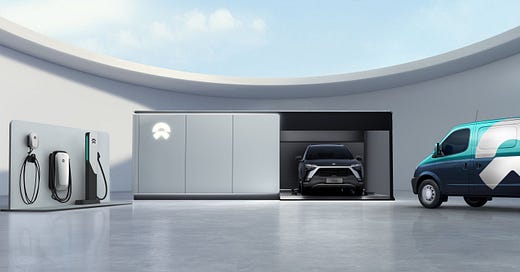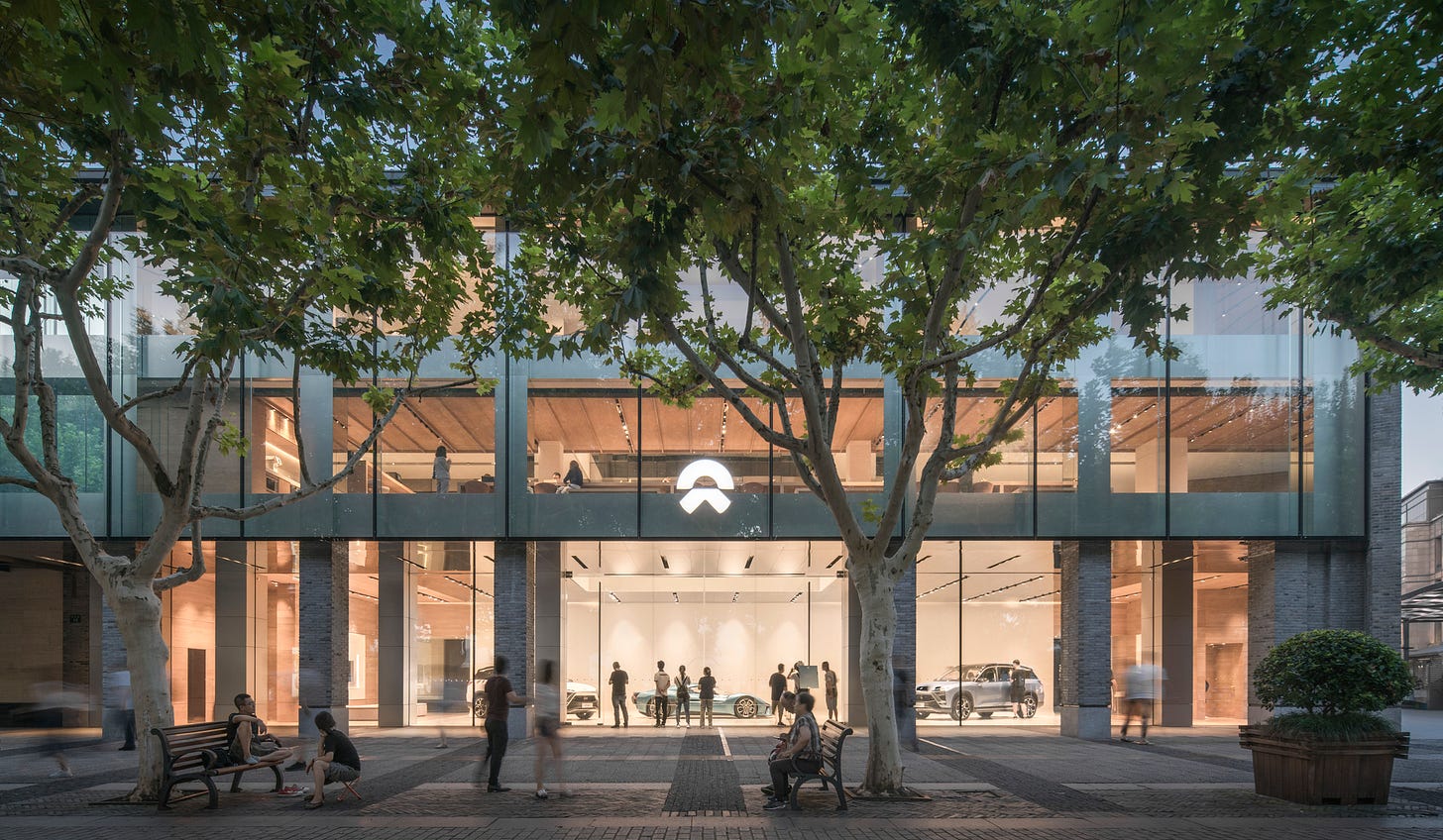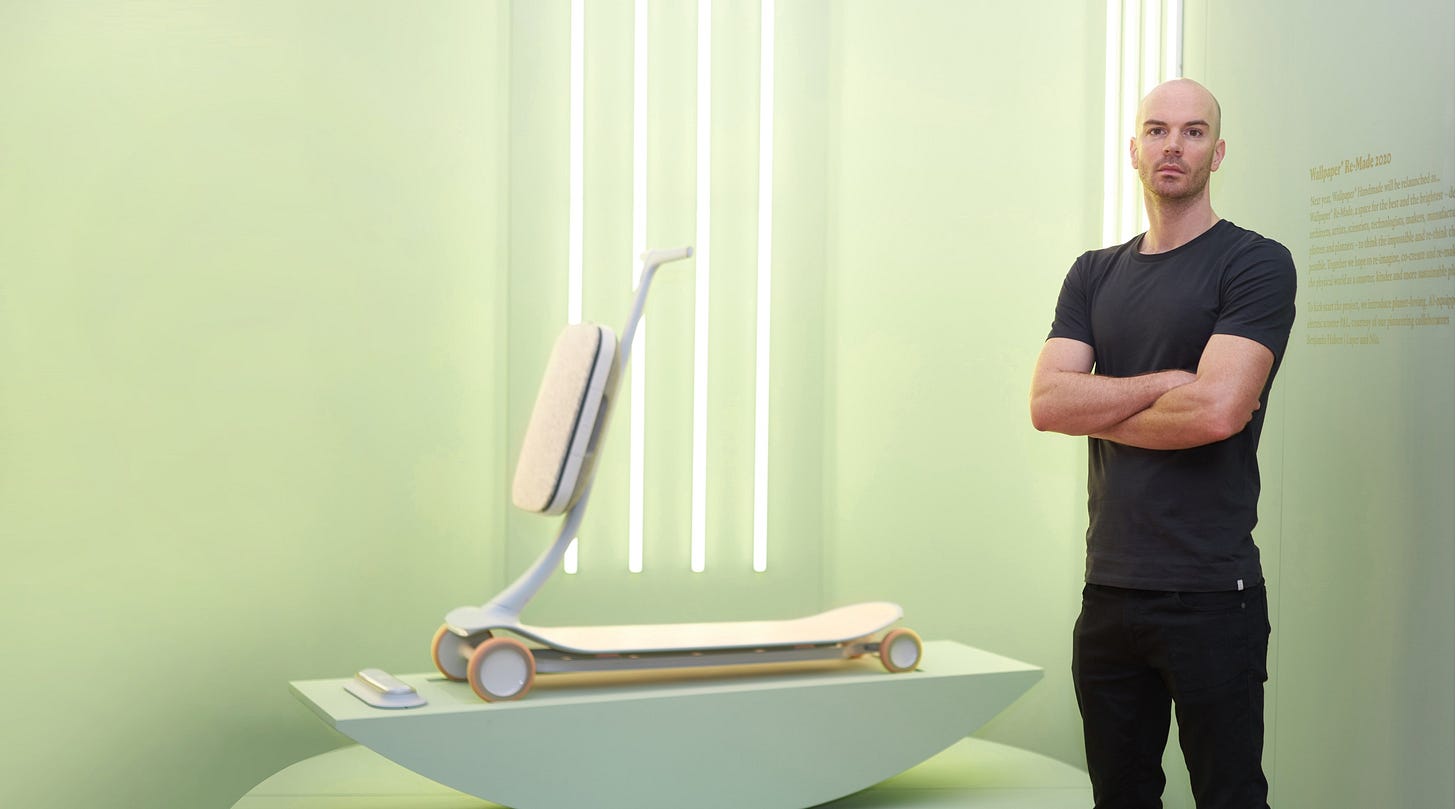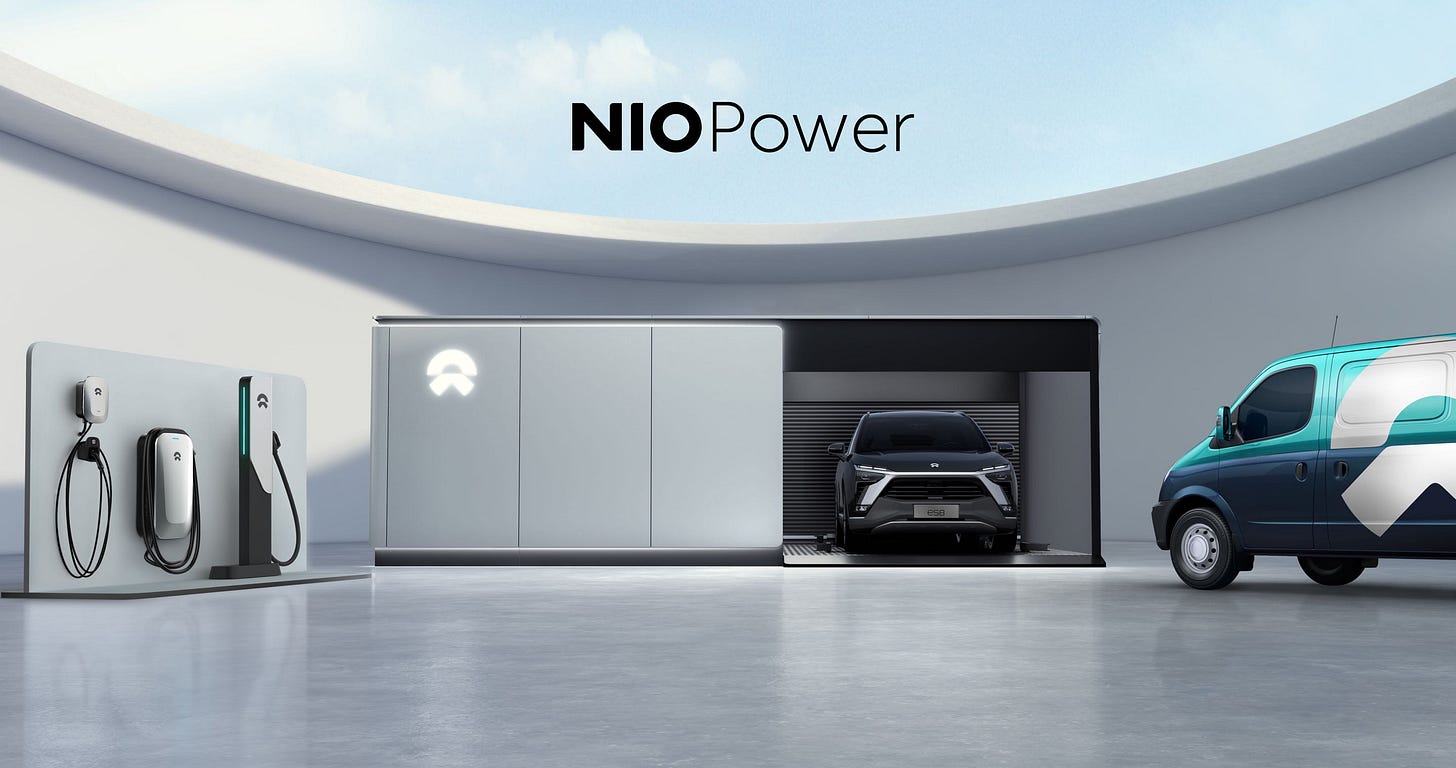NIO, an Experience-First Company
NIO is not simply a car company. Other than just designing cars, they are designing a lifestyle. They are building a brand that grows with the community, allowing people to live and share experiences together. NIO is a design driven company, that leverages technological innovation to create unique and worry-free experiences for its users. They want to redefine premium services along with the ownership experience of the automotive industry. By trying to anticipate change for automakers, they are making a paradigm shift in user experience and product innovation.
A shared vision for the future
NIO is a Chinese company known for producing smart EVs, providing premium services and creating innovative charging solutions.
The name translated from the Chinese (Weilai) means "Here comes the blue sky" and stands for its commitment to environmental change. The company was born because of high pollution in China and its founder's prior experience in the automotive industry.
The founder is William Li, a Chinese billionaire who earned his money from a car e-commerce business and reinvested it to create his new venture. He was not the only one who believed in his vision. Along with him we find other supporters such as Pony Ma (CEO of Tencent), Richard Liu (former founder and CEO of JD.com), Lei Jun (founder and CEO of Xiaomi) but also Lenovo and Sequoia.
During an interview, William said that he sees 4 paths for the future experience of a car brand: the car (hardware), the service, the digital touchpoints and going beyond the car. For him, what it takes to build the future is combining these 4 paths together.
A global startup
They define themselves as a global startup, bridging talents across the world. Their offices around the globe include: headquarters in Shanghai, design team in Munich, software development team in Silicon Valley, and the vehicle performance team in London.
NIO's story begins in 2014, when it was still called NextEV. The Formula E championship had just started and NIO won the title of world champion for the first edition. Next, they build the first car NIO EP-9, which becomes the fastest autonomous supercar. In 2017, during the first NIO Day in Beijing they launched their first model available to consumers, NIO ES8.
Customer centric as a competitive advantage
What really makes NIO stand out among the many EV players is their business model and approach to the industry. They don’t really care about having the latest battery or the longest range because they are focused on their customers and building great experiences for them.
In the automotive industry today, traditional companies don’t own many touchpoints in the experience. Their business model makes it clear that their success also comes from having natural, human, long-term touchpoints with their users. To build a user-oriented company, it takes more than treating your users well. You cannot only rely on slogans or superficial interactions.
Since their goal is to best serve the interests of their users, they also have a User Relations Department devoted to that. User relationships are very important in NIO’s system and that department defines the rules for their user community.
For many traditional automakers the purchase is the ultimate step in the customer journey. NIO regards the purchase as the entering of users in the ecosystem and the possibility to interact with them: long-term and mostly through human touchpoints. Like when they can come to your house to help you choose the color for your next NIO car.
Treat car like smartphones
It seems that they are treating their hardware products, cars specifically, as if they were smartphones. Cars and smartphones are key companions in our lives. If they work together well, customers are happy.
NIO is giving simple designs and names to its car models (like Tesla). Cars, like smartphones, are a means to express personality and status. So NIO allows you to fully custom and accessorize them. Even after you bought one, you can continue personalizing it through the app and services. To continue to highlight this symbiosis, NIO recently unveiled a phone that pairs with its EVs.
They define their cars as “user-experience defined vehicles”, allowing for continuous Firmware-Over-the-Air (FOTA) updates that improve the user experience. It is like hardware that relies and software and software updates influence the hardware experience.
“NIO’s user experience defined vehicles are much more than software-defined vehicles. We design our digital architecture to be able to apply very quickly the new maturing technologies such as chipsets, sensors, algorithms, training models, cloud, connectivities, safety and security.”
—Mark Zhou, NIO’s Executive Vice President and Chairman of Product Committee
NOMI, a virtual travel companion
Even before artificial intelligence became a mainstream trend globally, NIO decided to put a virtual assistant inside its cars. It’s called NOMI and it has a face, or rather an avatar. It is the result of co-creation between the NIO UI/UX team in Munich and Star for ideation and design. They took in consideration the whole design process holistically, including user journeys, industrial design, UX and visuals. This collaboration enabled them to win the Red Dot Design Award in 2020.
NOMI is designed to have a personality, so they give it two eyes and it doesn't feel like talking to the air. It should be a friendly companion, creating trust with AI and representing the emotional bond between driver and vehicle. Talking to NOMI through voice interactions allows you to control and adjust the car with your voice but also take selfies. This assistant also plays a crucial role in product improvement. Users can talk to NOMI and say "I want to give feedback."
Welcome to the NIO Ecosystem
From the very beginning NIO focused on building their own ecosystem, including the app, the services, NIO House and NIO Life. Cars are at the center of the ecosystem but they are not the only thing that matters. They act as an enabler for the rest of the offering built around experiences.
NIO Houses are an important part of the ecosystem and focus on the social aspect of the experience. This offline channel is a place to bring the community together. They are showrooms, similar to Apple Stores in appearance but also because they are multifunctional spaces with many activities. These open and enjoyable spaces are designed for users to share interests and experiences together. Not only vehicles, but also cafes, conference rooms, libraries or workstations. With NIO points you can also buy other services, such as drinks and venue rentals, and if you have children, they have designed a graceful space to let them play. They host many events for the community, promoting art, culture but also yoga classes. To this day there are 110 venues located in strategic areas of major cities around the world. By doing this they are creating a “brand community” model based on word-of-mouth and brand loyalty, as IKEA did with its meatballs next to the store.
NIO Delivery Centers are larger facilities that share elements in common with NIO Houses, where customers can pick up their vehicles (instead of waiting for home delivery) or be assisted during the initial configuration. These centers are an important touchpoint in the customer experience because they provide a physical location for customers to receive their vehicles and receive any necessary information or assistance.
NIO Life is an e-commerce through which NIO shapes the lifestyle associated with its brand. The company collaborates with Tom Dixon and more than 600 other talented designers around the world to introduce well-designed products into everyday life. These products have secured the brand several international design awards, demonstrating that their strategy is not only to whitelabel, but also to create highly differentiated and recognizable objects. These include fashion garments designed with reclaimed materials from the automotive industry and have developed a partnership with French wineries to jointly develop NIO's exclusive vineyards.
NIO Lifestyle App with more than 400,000 daily users, follows the model of chinese super apps. It incorporates NIO Life inside together with various social network functionalities where NIO customers can interact directly with each other, post content, and exchange their experiences. Their app users are more than their actual car users. That’s how they use the app to convert prospects into customers.
NIO Financial services In 2020, NIO established the "NIO Financial Leasings Co." to facilitate car financing with lower interest rates. In 2022, it also began offering the option to purchase batteries separately for customers who initially chose different payment plans, along with a service charge. When NIO entered the European market, it introduced several subscription models, including:
Leasing through third parties, especially for corporate customers.
Short- or long-term vehicle and battery subscriptions with flexible terms, including insurance, maintenance, free charging for the first 6 months, and the option to return the vehicle at any time.
Fixed-term lease of the vehicle and battery for a specified duration, with a 10% cost reduction compared to flexible leasing.
Purchase of the vehicle without the battery and battery lease (BaaS), offering cost savings and subscription options.
Purchase of the vehicle and battery together, which does not allow the use of battery replacement stations as in China.
Competing with Tesla
One of NIO's biggest rivals is Tesla. The two companies share many common traits, such as the desire to revolutionize the automotive industry with smart self-driving EVs and to go beyond cars or even the fact that they were both founded by billionaires who reinvested their own money to start the company. Because you know, it is very difficult to start a car brand from 0, even more so with your own money. Many fail and the competition is really high, NIO's ups and downs in the market in recent years have shown that. Although Tesla occupies a large share of the EV market in China and globally, it is not a battle to the death in which only one will remain. As NIO's co-founder says: “The automotive industry is not winner takes all. Even with extremely good performance, one player can take only a 10 to 15 percent market share at most.”
Battery as a Service (BaaS)
One of the major innovations in the NIO ecosystem is the subscription service introduced in 2020. The subscription also includes different services such as: maintenance, warranty, remote diagnostic monitoring, and battery swapping. This business model innovation is one of their main strengths today. NIO BaaS users can purchase a car without a battery for $10,000 less. In addition, they can subscribe to battery packs of various capacities according to their needs and pay on a monthly basis.
Those who subscribe are entitled to NIO's Power Swap and flexible battery upgrade services. The interesting thing is that NIO cars are modular, meaning that the same battery can fit them all. Their battery swap has disrupted and radically changed what was for traditional cars the gas station experience for the better. Users go into one of their proprietary stations and the car's battery is replaced within 4-5 minutes with a new one. NIO with an experience-first approach makes life easy for its users. In this way, they do not have to worry about and depend on their battery technology.
Although this innovation separates NIO from the rest of its competitors, Tesla had already thought about it in 2013 when they tried to introduce battery swapping in California. Unfortunately, users were reluctant because the Supercharger was fast enough.
This shift represents not only the physical separation of the batteries from the cars, but the separation of the ownership of the batteries. This reminds me of the similar Product as a Service (PaaS) model that is adopted by some automotive players.
Community-driven Strategy and Growth
NIO’s growth is driven by its users. To make its community function at its best, NIO has established a user service system with the following strategies:
Due to the referral program, they can invite a friend and get points if he does a test drive or buys a car. These points can be used for purchasing their lifestyle products at NIO Life, coupons, event tickets and some other rewards at NIO House. Another way to accumulate points is by being active in their community. Their strategy is to systematically increase the proportion of new users referred by existing users.
In addition to referrals, they use large events as a means to achieve massive impact. The first NIO Day in 2017 resulted in them receiving half of their annual orders in 24 hours.
Once users are inside the NIO ecosystem, there are 3 systems that drive growth: points, coupons, and NIO Value. Points are exchanged for gifts and other benefits. Coupons are for drinks, one-click refills, destination mobility, etc. NIO Value based on each user's degree of activity in the NIO community and their contribution.
The NIO community within the app is designed to create a social circle for ordinary users. The app makes it easier for users to find like-minded people based on hobbies, regions, and industries. In addition, a membership system has been created to create a high-level social circle.
NIO Future Strategy
NIO's direction for the future is in transition towards the mobility as a service model (MaaS), where their vehicles can become an integrated part of the mobility system, so they can focus mostly on the experience for the users. In 2019, they started a collaboration with Mobileye (part of Intel) and at the beginning of 2023 they started launching the robo-taxi service on a fleet of ES8 models.
For those who are curious
A Critical Review of NIO’s Business Model
Electric Cars of China: Founder Story of NIO
McKinsey interview with NIO co-founder and president
NIO Launches Battery as a Service
NIO User-Experience-Defined Vehicles
The Story of NIO’s Design Headquarters














